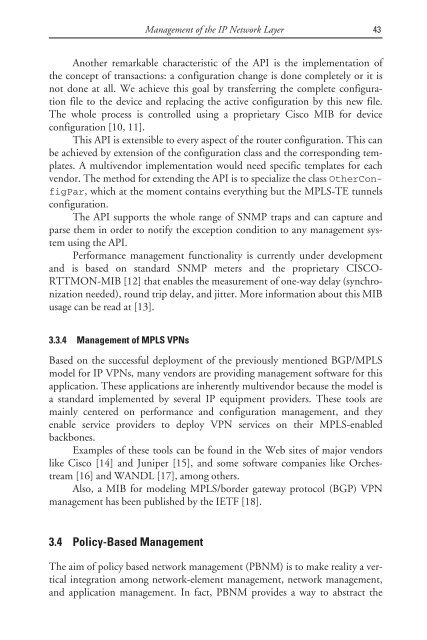deploying and managing ip over wdm networks - Index of
deploying and managing ip over wdm networks - Index of
deploying and managing ip over wdm networks - Index of
You also want an ePaper? Increase the reach of your titles
YUMPU automatically turns print PDFs into web optimized ePapers that Google loves.
Another remarkable characteristic <strong>of</strong> the API is the implementation <strong>of</strong><br />
the concept <strong>of</strong> transactions: a configuration change is done completely or it is<br />
not done at all. We achieve this goal by transferring the complete configuration<br />
file to the device <strong>and</strong> replacing the active configuration by this new file.<br />
The whole process is controlled using a proprietary Cisco MIB for device<br />
configuration [10, 11].<br />
This API is extensible to every aspect <strong>of</strong> the router configuration. This can<br />
be achieved by extension <strong>of</strong> the configuration class <strong>and</strong> the corresponding templates.<br />
A multivendor implementation would need specific templates for each<br />
vendor. The method for extending the API is to specialize the class OtherConfigPar,<br />
which at the moment contains everything but the MPLS-TE tunnels<br />
configuration.<br />
The API supports the whole range <strong>of</strong> SNMP traps <strong>and</strong> can capture <strong>and</strong><br />
parse them in order to notify the exception condition to any management system<br />
using the API.<br />
Performance management functionality is currently under development<br />
<strong>and</strong> is based on st<strong>and</strong>ard SNMP meters <strong>and</strong> the proprietary CISCO-<br />
RTTMON-MIB [12] that enables the measurement <strong>of</strong> one-way delay (synchronization<br />
needed), round tr<strong>ip</strong> delay, <strong>and</strong> jitter. More information about this MIB<br />
usage can be read at [13].<br />
3.3.4 Management <strong>of</strong> MPLS VPNs<br />
Based on the successful deployment <strong>of</strong> the previously mentioned BGP/MPLS<br />
model for IP VPNs, many vendors are providing management s<strong>of</strong>tware for this<br />
application. These applications are inherently multivendor because the model is<br />
a st<strong>and</strong>ard implemented by several IP equ<strong>ip</strong>ment providers. These tools are<br />
mainly centered on performance <strong>and</strong> configuration management, <strong>and</strong> they<br />
enable service providers to deploy VPN services on their MPLS-enabled<br />
backbones.<br />
Examples <strong>of</strong> these tools can be found in the Web sites <strong>of</strong> major vendors<br />
like Cisco [14] <strong>and</strong> Jun<strong>ip</strong>er [15], <strong>and</strong> some s<strong>of</strong>tware companies like Orchestream<br />
[16] <strong>and</strong> WANDL [17], among others.<br />
Also, a MIB for modeling MPLS/border gateway protocol (BGP) VPN<br />
management has been published by the IETF [18].<br />
3.4 Policy-Based Management<br />
Management <strong>of</strong> the IP Network Layer 43<br />
The aim <strong>of</strong> policy based network management (PBNM) is to make reality a vertical<br />
integration among network-element management, network management,<br />
<strong>and</strong> application management. In fact, PBNM provides a way to abstract the


